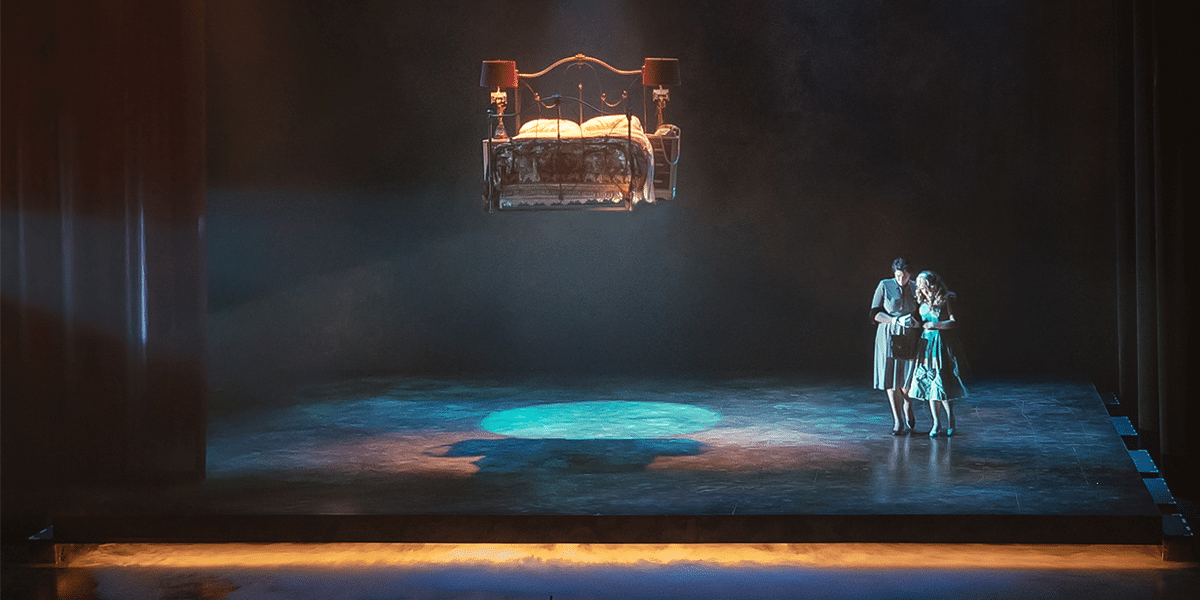In today’s visually driven world, the importance of theater designers in a show’s storytelling cannot be overstated. Recently, I had the privilege of speaking with Christian Fleming, a set and costume designer whose career has been dedicated to exploring the rich intersection of art and narrative. With a profound passion for theater—especially musicals—Fleming’s creative journey is fueled by the belief that design can ignite the audience’s imagination, transforming them into active participants in the unfolding narrative.
Bridging Imagination and Realism
One of the hallmarks of Fleming’s work is his ability to merge creative imagination with the reality of a production’s logistical demands. In productions such as Madwomen of the West – which premiered earlier this year off-Broadway starring Marliu Henner (Taxi) and Caroline Aaron (Marvelous Miss Maizel) – and Outside In, a new immersive play that premiered at Lincoln Center, Fleming’s sets are not just visually appealing; they speak directly to the narrative’s essence. Fleming’s work exemplifies their skill in balancing bold artistic concepts with functional execution, offering audiences a seamless, believable world.
The Significance of Audience-Centric Design
Fleming describes their artistic philosophy as distinctly audience-centric. They assert that every sensory element presented to the audience must be crafted with intention. While it’s easy for creators to become lost in their conceptual visions, Fleming emphasizes the critical need to prioritize the audience’s experience. “Design is fundamentally about storytelling,” they explain. “The choices we make regarding the world and characters provide context that guides the audience’s focus. By analyzing each production through the lens of the audience’s experience, I distill complex ideas into tangible decisions.”
Additionally, this audience-centric design philosophy also acknowledges that modern theatergoers seek more than just visual appeal; they want an experience that resonates emotionally and intellectually. Fleming’s approach, grounded in thorough research and attention to detail, meets this demand by creating environments that feel lived-in and authentic, making stories more relatable and engaging.
How Christian Fleming’s Techniques Enhance Storytelling
Fleming’s work reinforces the idea that every design choice communicates something significant. Whether it’s the colors used to evoke certain emotions or the minimalism of a particular set to focus attention on an actor’s performance, these decisions shape how the story is received. Their techniques ensure that designs never overpower the narrative but complement and deepen the audience’s understanding of the plot and characters.
A striking example of this philosophy in action is Fleming’s work on “The Light in the Piazza.” Here, they recognized the importance of transporting the audience to the romantic allure of Florence, mirroring the characters’ journey. Instead of conventional scene transitions with furniture being moved, Fleming chose an ethereal approach, allowing pieces to gently float in and out of scenes. “This method beautifully encapsulated the sweeping romance, immersing the audience in a new yet familiar world,” they shared. “Watching scenes conclude with furniture drifting away, accompanied by the delicate sounds of strings and harps, was a breathtaking experience.”
Integrating Visual Contexts for Emotional Depth

Dear Jack, Dear Louise – Penguin Rep
Fleming’s design for Ken Ludwig’s latest play, “Dear Jack, Dear Louise,” a co-production between Penguin Rep and Shadowland Stages, further exemplifies their nuanced approach to storytelling. Set amid World War II, the design choices help transport the audience back in time. From the carefully selected color palette reminiscent of vintage wartime posters to the period-specific costumes that reflect the characters’ emotions and social context, every detail serves a purpose. The use of thousands of love letters was a particularly notable design gesture that Fleming used to not only enhance the authenticity of the setting, but also deepen the audience’s connection to the central characters’ love story. “These small design elements are crucial in transporting the audience to a time of uncertainty and hope,” Fleming explains. “They help to create a world that feels lived in and real, allowing the audience to empathize closely with the characters’ struggles and triumphs.”
When initiating a new design project, Fleming employs a structured, yet adaptable approach. They begin by deeply immersing themselves in the story, characters, and underlying themes, carefully pondering the central dramatic questions posed by the script. “I engage in dramaturgical research to explore the socio-political and ideological dimensions,” they note. “However, I strive to keep my initial thoughts flexible, fostering openness during early team discussions. Each collaboration unveils fresh insights into our world and the human experience.” Once a direction is established, Fleming distills visual inspiration to capture the production’s poetic essence, ensuring that every design element aligns with the overarching narrative.
The Impact of Design Choices on Audience Perception

Sunday in the Park with George – Titusville Playhouse
Another noteworthy example of Fleming’s impact can be seen in their design for the critically acclaimed production of “Sunday in the Park with George,” produced by Titusville Playhouse this past spring. Fleming’s innovative choice to set the show in George’s art studio not only provided a visually stunning backdrop, but also deepened the exploration of the play’s central themes of art versus life and the creative process. The studio, filled with canvases, palettes, and unfinished works, became a character in its own right, reflecting George’s inner turmoil and artistic aspirations. This intimate setting allowed the audience to witness the juxtaposition of creation and reality, highlighting the struggles and joys of the artistic journey. By immersing the audience in George’s world, Fleming’s design invited deeper contemplation on how art captures fleeting moments and emotions, ultimately resonating with the universal quest for meaning and the balance between personal sacrifice and creative fulfillment.
Through their passion and innovative methodology, Fleming is redefining the landscape of visual storytelling in theater. As audiences evolve, so do the demands placed on theatrical design. Fleming’s vision adapts to these shifts, experimenting with emerging trends while maintaining the core principles that define their work. This balance ensures that their designs remain fresh and relevant, continually pushing the boundaries of how stories can be told through set and costume. By prioritizing audience experience, Fleming creates designs that not only enhance the narrative, but also invite audiences to delve deeply into the story’s world, crafting a shared experience that lingers long after the curtain falls.
Contact Information
For more insights into Christian Fleming’s work or to collaborate, visit www.christianfleming.design or follow their creative journey on Instagram at @christianflemingdesign.
Published by: Holy Minoza

















